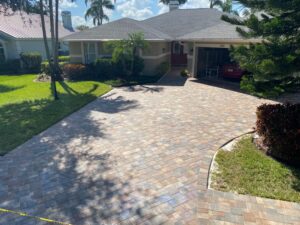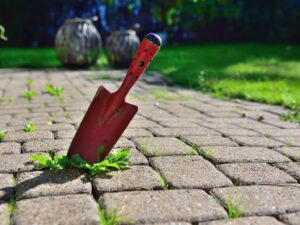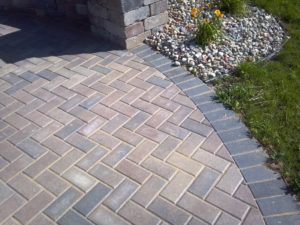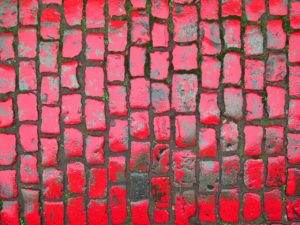Creating a stepping-stone project is an excellent way to enhance the aesthetics and functionality of your outdoor space. Today, we want to tackle some inexpensive stepping stones walkway ideas to enhance your area without hurting your pocket.
Stepping stone walkways not only add charm and character to your garden or backyard but also provides a practical solution for navigating through your landscape.
They can be made from a variety of materials, including concrete, natural stones, or even recycled materials, allowing you to customize the look of your path to suit your personal style and the overall theme of your outdoor area.
So if you are on a budget but still want to revamp your walkway, this article will explore a plethora of inexpensive stepping-stone walkway ideas that will help you create a beautiful and unique path without breaking the bank.
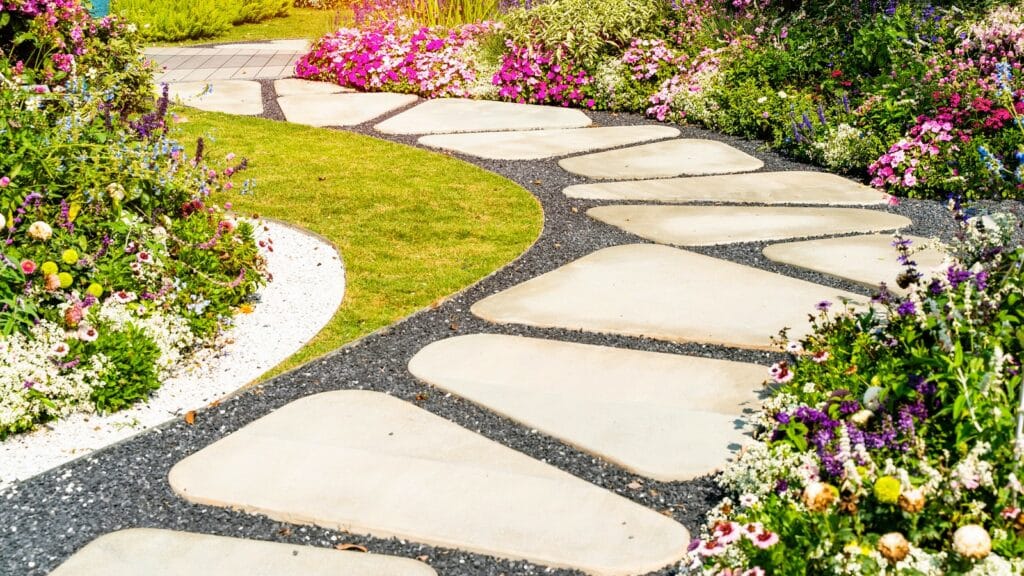
Inexpensive Stepping Stones Walkway Ideas: Material Options
One very cost-effective option for creating a stepping-stone walkway is to use concrete pavers.
They are pre-made concrete blocks that come in various shapes, sizes, and colors. Concrete pavers are relatively inexpensive and easy to install. You can arrange them in a straight line for a traditional look, or get creative by arranging them in patterns or curves to add visual interest to your walkway.
Another budget-friendly option is to repurpose materials you may already have or can acquire at a low cost. For example, you can use discarded bricks, broken pieces of concrete, or even old wooden planks to create stepping stones.
These materials can be arranged in a mosaic pattern, creating a unique and artistic pathway. Not only does this approach save money, but it also gives your walkway a rustic and eclectic charm.
If you want to add a touch of natural beauty to your walkway, consider using natural stones as stepping stones. These stones can be sourced locally, such as river rocks or flagstones, which are readily available and cost-effective.
Natural stones provide a more organic and earthy feel to your pathway, blending harmoniously with the surrounding landscape. You can either use stones of the same shape and size for a uniform look or mix and match different stones for a more eclectic design.
For an eco-friendly and budget-conscious approach, consider using recycled materials to create your stepping-stone walkway. For instance, old glass bottles can be embedded upside down in the ground to create a colorful and eye-catching pathway.
You can also repurpose old tires by cutting them into circular shapes and filling them with gravel or decorative stones. These creative and sustainable ideas not only save money but also reduce waste by giving new life to discarded materials.
To further enhance the aesthetics of your stepping-stone walkway, consider incorporating plants and greenery. You can create small planting pockets between the stepping stones and fill them with low-maintenance ground covers or colorful flowers.
Cheapest Natural Stone Options
Even with all these options available, many homeowners still want that classic look that only natural stones can provide.
Bear in mind that you can easily simulate that look with the right kind of concrete paver, which is much cheaper than any natural stone. Nevertheless, if you still want natural stone, there are a few cheaper options you can work with.
Don’t miss: What Are the Best Pavers for a Sidewalk?
Slate
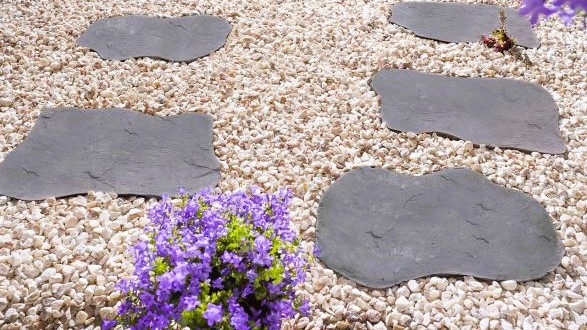
Slate, a remarkable natural stone, is highly regarded for its versatility and cost-effectiveness. It presents an array of captivating colors, including shades of gray, green, black, and even purple.
This diverse palette provides ample options to suit different design preferences and complement various interior and exterior aesthetics.
One of the most notable qualities of slate is its exceptional durability. As a sedimentary rock, it undergoes a process of intense pressure and heat over time, resulting in a dense and sturdy material.
This inherent strength makes slate an excellent choice for high-traffic areas, as it can withstand the rigors of daily use without showing signs of wear or damage.
Another significant advantage of slate is its resistance to fading. This characteristic is particularly beneficial in spaces that receive prolonged exposure to sunlight, as some materials may lose their vibrancy over time.
The cost of slate can vary depending on several factors, including the type of slate, its quality, origin, availability, and the region where you’re located. Additionally, the cost may also be influenced by the size, thickness, and finish of the slate tiles or slabs.
On average, slate tiles can range from $5 to $20 per square foot, but it’s important to note that installation costs should also be considered when budgeting for slate.
Sandstone
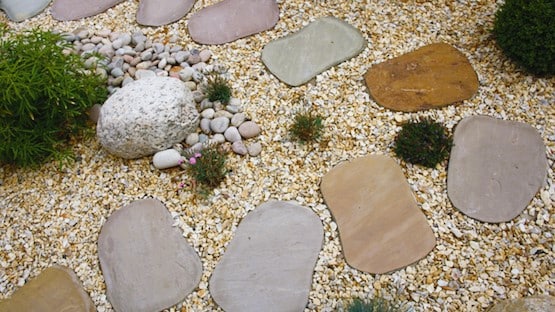
Sandstone, an affordable and readily available natural stone, offers a plethora of warm and earthy colors, making it an excellent choice for various design projects. Formed from sand grains, sandstone possesses inherent durability and versatility, rendering it suitable for many exterior applications.
One of the distinguishing characteristics of sandstone is its wide range of warm and earthy colors. From subtle beige and golden tones to rich reds and browns, sandstone provides a diverse palette that can harmonize with different design styles and complement various color schemes.
As a sedimentary rock, sandstone’s composition of compacted sand grains contributes to its durability. It is capable of withstanding heavy foot traffic, making it an ideal choice as stepping stones for walkways.
The cost of sandstone can vary depending on several factors, including the type of sandstone, its quality, origin, availability, and the region where you’re located. Additionally, the cost may also be influenced by the size, thickness, and finish of the sandstone tiles, slabs, or blocks.
On average, sandstone tiles can range from $4 to $10 per square foot, while larger sandstone slabs or blocks for more substantial projects can cost between $20 and $40 per square foot.
Limestone
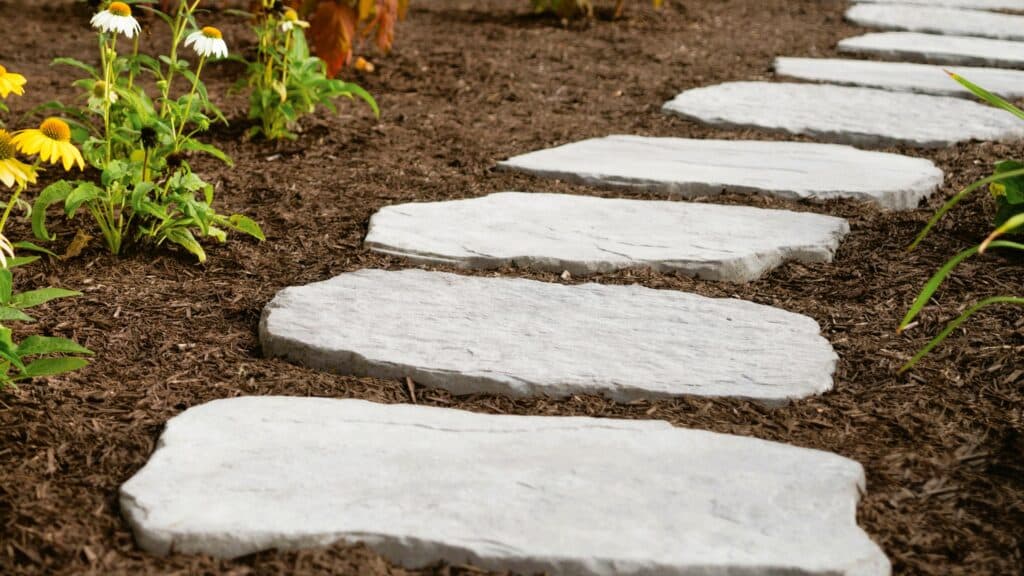
Limestone, renowned for its classic and timeless appeal, stands out as a cost-effective natural stone option. This sedimentary rock exhibits an array of inviting shades, including beige, tan, and gray, which contribute to its widespread popularity in various design applications.
Limestone lends itself well to different interior and exterior projects, being commonly used for flooring and providing an elegant foundation for any room. Whether in a traditional or contemporary setting, its soft and muted hues create a serene and welcoming ambiance, setting the tone for a comfortable living space.
Beyond its aesthetic qualities and cost-effectiveness, limestone also boasts excellent durability. While it is a relatively softer stone compared to some other natural stones, proper care and maintenance can ensure its longevity.
On average, limestone tiles can range from $3 to $10 per square foot, while larger limestone slabs or blocks for more substantial projects can cost between $10 and $50 per square foot.
These price ranges are estimates and can vary significantly based on the same factors we mentioned for the previous stones.
Travertine
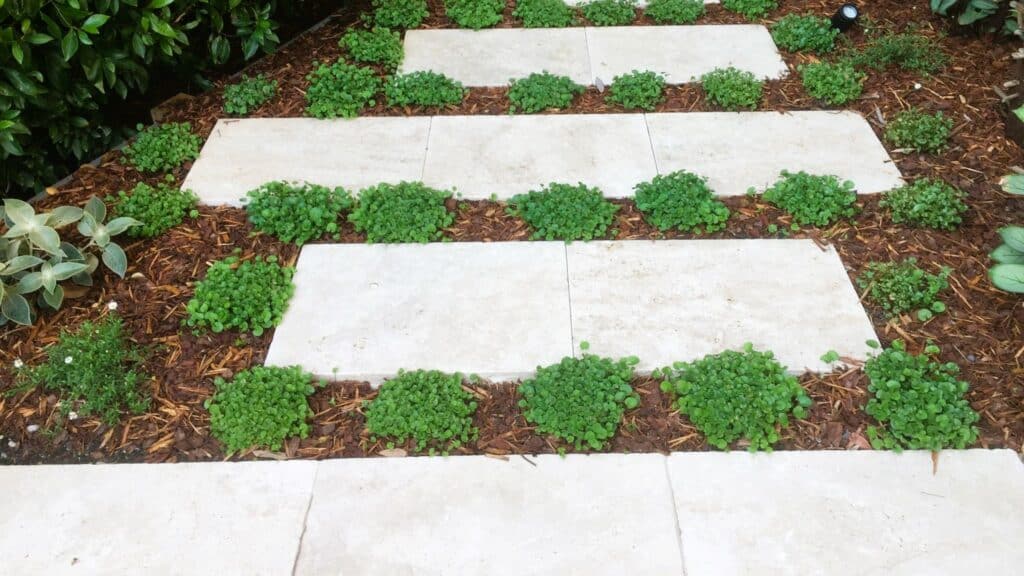
Travertine is a captivating natural stone formed through the precipitation of calcium carbonate near hot springs, standing out as an affordable and elegant alternative to marble.
This remarkable stone boasts a wide range of warm and inviting colors, including shades of beige, ivory, and gold. With its unique patterns and texture, travertine adds a touch of sophistication and charm to any space it graces.
Travertine’s warm and earthy color palette is one of its most appealing characteristics. Ranging from creamy beige tones to soft ivory hues and rich golden shades, travertine effortlessly complements a variety of interior styles and color schemes.
Travertine finds extensive use in flooring, where its durability and visual appeal shine, making it an excellent choice as a stepping stone.
Its dense composition allows it to withstand the rigors of daily foot traffic, making it a suitable choice for high-traffic areas in both residential and commercial settings. The unique patterns and textures inherent in travertine create a dynamic and visually captivating floor surface that becomes the centerpiece of any room.
Travertine tiles can range from $3 to $15 per square foot, while larger travertine slabs or pavers for more substantial projects can cost between $15 and $30 per square foot. These price ranges are estimates and can vary just like the other stones.
Granite Tiles
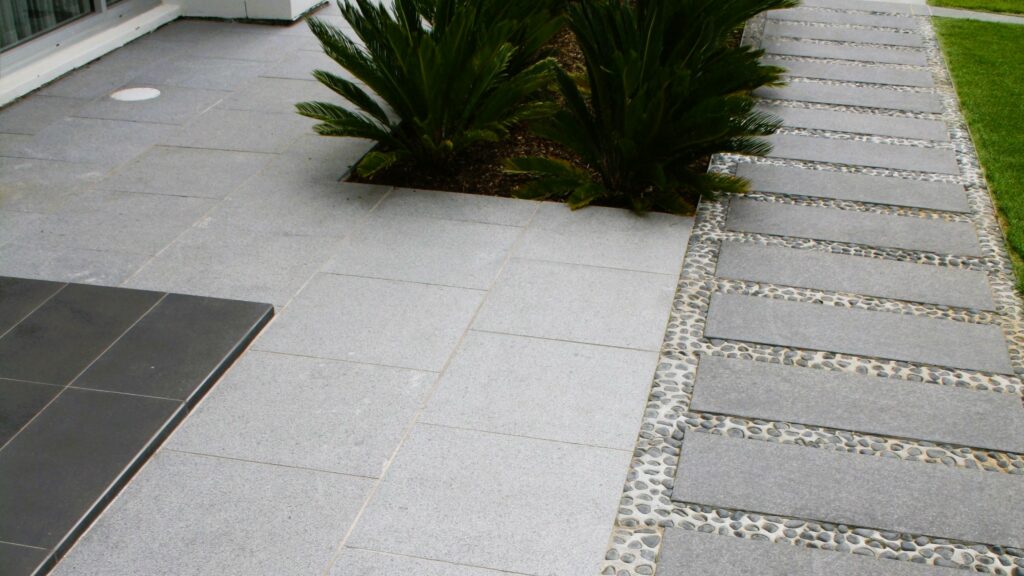
Granite is renowned for its durability and captivating natural beauty. While it is often considered an expensive option when opting for solid slabs, granite tiles are a cost-effective alternative that allows you to enjoy the benefits of granite without breaking the bank.
They offer the same elegance, strength, and timeless appeal as their solid slab counterparts. They are cut from granite blocks and are available in various sizes, thicknesses, colors, and patterns, providing you with a wide range of design possibilities.
Granite flooring is a popular choice due to its exceptional strength and resistance. Whether in high-traffic areas or more intimate spaces, granite tiles provide a durable and visually striking flooring option. The natural patterns and colors found in granite create a unique and eye-catching aesthetic, enhancing the overall design of the room.
On average, granite tiles can range from $5 to $15 per square foot, but it’s advisable to consult with suppliers and contractors in your area to obtain accurate pricing information for your specific project.
Inexpensive Stepping Stones Walkway Ideas: Start Your Project Today
As you could see, there are many inexpensive stepping stones walkway ideas you can follow. From some cheapest natural stone options to even other materials, like concrete or recycled brick.
The best thing you can do before making any final decisions is to consult with a professional hardscape contractor. Every installation has its own unique characteristics, and no decision is trivial when it comes to hardscape projects.
We here at S&S Pavers, over our 13 years of experience, have seen many installations that could have been amazing, but because of a small mistake, things went downhill. So we always recommend hiring a professional in your area you can trust.
And if you happen to be around our area of service, the Sarasota and Manatee counties, in FL, why not contact us to help you with your project? We would be glad to hear from you.

